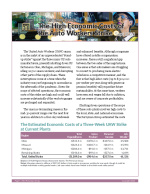The Economic Impact of the Auto Workers Strike
Published on September 21, 2023

The United Auto Workers (UAW) union is in the midst of an unprecedented "stand-up strike" against the three major US auto manufacturers, presently shutting down US factories in Ohio, Michigan, and Missouri; idling 12,700 union workers; and disrupting other parts of the supply chain. These interruptions come at a time when the industry was just beginning to normalize in the aftermath of the pandemic. Given the scope of affected operations, the economic costs of the strike are high and could well increase substantially if the work stoppages are prolonged and expanded.
Shutting down operations of the scope of these auto plants involves high costs to the local, state, and national economies. The Perryman Group estimated the costs of a work stoppage lasting three weeks and found that the US economy would see losses of an estimated -$414.6 million in gross product and more than -61,500 job-weeks of employment (including multiplier effects). Losses would be concentrated in the states where the facilities are located, but harms would spread across the country and involve a large spectrum of industries. (Note that transitory job losses are typically expressed in job-years, which is one person working for one year, though it could be multiple individuals working partial years. In this case, the employment losses are estimated during the assumed period of the strike and so expressed in job-weeks.)
Strikes involve substantial costs for the companies involved, their suppliers, and the economy as a whole. A prolonged interruption in automobile production could also exacerbate inflationary pressures. It is in the interest of both sides to come to an agreement that involves fair compensation for workers, but also allows companies to be competitive and survive. The longer the stoppages continue, the greater the harm.
For more details please refer to the full brief.
- Tags: auto production, strike, UAW, automotive, economic impact